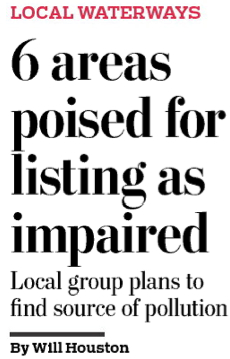8/15/14
The North Coast Regional Water Quality Board on Thursday recommended that six local waterways be federally listed as impaired due to high fecal bacteria concentrations, paving the way for those streams and rivers to obtain government-backed pollution control plans. “I’m pleased that the regional board took this action, which is a first step to addressing water quality impairments in the North Coast region,” board Executive Officer Matt St. John said.
The board recommended that the State Water Resources Control Board include the Little River, Widow White Creek, Martin Slough, lower Elk River, Jolly Giant Creek and Campbell Creek in its 2012 federal Clean Water Act’s list of impaired waters due to higher concentrations of fecal coliform bacteria, such as E. coli, than allowed by state regulations.
A recent study by Humboldt Baykeeper — which submitted the data to the regional board — showed that Jolly Giant Creek had 600 times the maximum concentration allowed. Fecal coliform pollution can come from several sources such as pets, agricultural runoff, septic failures, leaky pipes and transient camps.
Though not all the data her organization submitted was reviewed and one studied creek was left off the list, Humboldt Baykeeper Policy Director Jennifer Kalt said she thinks the regional board’s decision was “fantastic.”
“You know, it’s the first step to try to come up with solutions,” she said. “Hopefully, it will move a little faster than some of the past recovery plans.”
The list will now be passed to the State Water Board and, if approved, will go to the U.S. Environmental Protection Agency for a final determination. Should the waterways make it all the way through, a pollution mitigation plan will be developed for each one, including a watershed analysis to help identify the source of the pollutants. Though the plan is made with good intentions, Kalt said it takes several years — sometimes up to 15 — to be put into effect.
“Their workload is just compounding rapidly,” she said. “Until we find the sources and figure out what the sources are, no one is going to want to spend the money to solve the problem. ... I’m working to get funding to identify the sources, so we can move along instead of going on waiting 15 years for the water board to figure out what to do.”
After collecting data on fecal coliform for nine years on several waterways, Humboldt Baykeeper submitted its data to the regional board in 2010 to be considered for listing, though only data from 2005-2009 was used. Due to delays in funding, the regional board was unable to approve the 2012 list until this year. One of Humboldt Baykeeper’s study sites — Bullwinkle Creek — did not make it into the regional boards recommended list due to a technicality.
“What happened was there was a clarification from the state board about the number of samples and exceedances required to list a water body,” North Coast Water Board environmental scientist Katherine Carter said. “In this case, you need three samples with three exceedances. What we had submitted to use was two samples and two exceedances, and therefore we had to take it off.”
Humboldt Bay did not make the list, even though several of the listed tributaries occasionally run into it, which Kalt said was important.
“A lot of people see these proposed listings and get concerned about the oysters, because all the creeks run into the bay,” she said. “But the oyster growers test the water very, very frequently. They know because they have to. They know that the bay is fine for eating oysters except for when it rains and these (tributaries) run into the bay.”
The next time a water body can be listed as impaired — whether it be from fecal bacteria or high mercury levels like Ruth Lake — will be in 2018, but regional board environmental scientist Rebecca Fitzgerald said they will begin receiving data well ahead of that time.
“We will likely start in the next year or year-anda- half,” she said.
In the meantime, Kalt said the top priority is to gather data for Janes Creek, which runs through Arcata.
“We didn’t really have big data sets for Janes Creek,” she said. “One of our creek sites goes under 11th Street. Because it’s tidally influenced, you couldn’t be sure if you were sampling bacteria that was coming in on a high tide from the bay. We have much better data now.”



